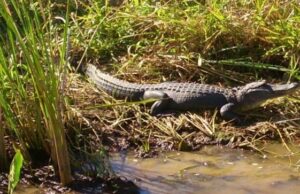Alligator Safe Work Practices
- By: Brett Buxbaum
- Health & Safety Director
- on

Pre-Job Inspection:
• Inspect the jobsite for alligator presence (nests, gator tracks, bank slides, bubble trails, sunning, and signs of predation events) before starting work.
• Determine if it is necessary to enter or work near the water.
• Evaluate if a better time could be selected (relative to temperature).
If working on Mosaic Sites:
• The Mosaic approved alligator trapper conducts a survey of nest locations from late June into early July. Each nest is given a GPS waypoint and compiled into a map that can be provided.
• If an aggressive or curious alligator is encountered, work shall be discontinued, and the Mosaic project manager notified of the situation.
• All findings shall be documented on a pre-job inspection sheet and kept on file.
Alligator Safety Tips:
• Florida Statute 372.667 prohibits feeding, killing, harassing, or the possession of alligators.
• Do not try to approach or capture. Even small ones can cause injury.
• Alligators are most active between dusk and dawn.
• Food shall not be consumed within proximity of a water body.
• Food scraps and garbage shall not be left onsite or tossed into the water. All food shall be disposed of in a trash container with a lid and removed offsite at the end of the workday.
• Do not enter or stand near waters that might be inhabited by alligators.
If an Alligator Attacks:
• Run away in a straight line. It will outrun a human for 30 feet.
• If it grabs you: hit it repeatedly on its nose, try to gouge/poke its eyes, and scream. Don’t try to pry open jaws.
• Seek immediate medical attention if bitten by an alligator. Bites often result in serious infection.
While Work Is Going On:
• Utilize the buddy system or tight group and have a safety spotter
• Do not enter the water alone or be separated by more than a reasonable distance from the group.
• Do not get outside of the group’s line of vision. The more limited the visibility, the tighter the group formation.
• A designated spotter should be in place to maintain visual contact with the crew members and assess environmental conditions.
• Maintain Situational Awareness of Self and Group
• Each crew member is expected to be aware at all times of their surroundings.
• Watch where you step and the placement of your hands and feet.
• Crew leaders and crew members shall spend a reasonable amount of time observing the water and banks each time before approaching or entering the water.
• In certain instances, a walking stick may be used to probe the path ahead and/or move vegetation aside to gain a better view.
• Address Safety Concerns and Mitigate Risks
• Any safety concerns related or unrelated to alligators shall be communicated to the supervisor immediately and mitigated before work may resume.

